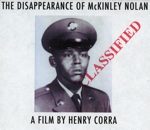
The Disappearance of McKinley Nolan, by Henry Corra
Corra Films Production in association with
Louverture Films, release in 2011.
All wars—and the Vietnam War is no exception—have a way of becoming backdrops for amazing individual stories of heroism, adventure, intrigue, violence and just plain weirdness. McKinley Nolan’s story fits into the latter three categories.
A young African-American from a small Texas town, Nolan was a 1st Infantry Division private serving near Saigon when he went AWOL on November 9, 1967, following a stint in the Long Binh stockade. His family, which included a young wife back home in Texas, never heard from him again. But reports surfaced—official and unofficial—that Nolan had gone over to the other side, married a Vietnamese woman and had a child. Adding to the intrigue were statements allegedly by Nolan broadcast by Viet Cong “Liberation Radio,” calling upon American soldiers to give up the fight.
Nolan’s trail went cold until 1973, when reports surfaced that he and his Vietnamese family were living with the Khmer Rouge in Cambodia. Then, in 1977, during the Cambodian Holocaust, McKinley Nolan and his family disappeared. His American wife Mary and the rest of his family have not heard anything from him, nor from the U.S. military or government, in all those years.
In 2005, Vietnam veteran Dan Smith, who was on a trip back to the former war zone, ran into a middle-aged African-American man in Tay Ninh City. When Smith asked the man his name, he mumbled something that Smith believes was “McKinley Nolan,” before he then disappeared. The story of that brief chance encounter opens the riveting documentary film from Henry Corra, The Disappearance of McKinley Nolan.
The film begins with Smith, who was seriously wounded in Vietnam and also suffered emotionally afterward, relating the tale of that strange meeting in Tay Ninh. Corra’s cameras then follow Smith on an emotionally charged visit to McKinley Nolan’s wife Mary and other members of his family. The story shifts to October 2008 when Corra accompanied Smith and Nolan’s brother Michael to Vietnam and Cambodia.
In Vietnam, they meet several former Viet Cong who tell them tales of their brother, including, they say, that he killed two or three U.S. military policemen before he went over to their side. The Americans also meet Nolan’s Vietnamese stepson, who accompanies the group to Cambodia, where they find several former Khmer Rouge fighters who knew Nolan and his Vietnamese wife. It is this encounter with the Cambodians that convinces the Americans that McKinley Nolan, his Vietnamese wife and their child were killed by the Khmer Rouge.
While the film is a first-rate production, a minor problem is the use of certain war-time footage images that don’t fit the narrative—most egregiously is an ARVN general’s execution of a VC prisoner in Saigon.
Marc Leepson




